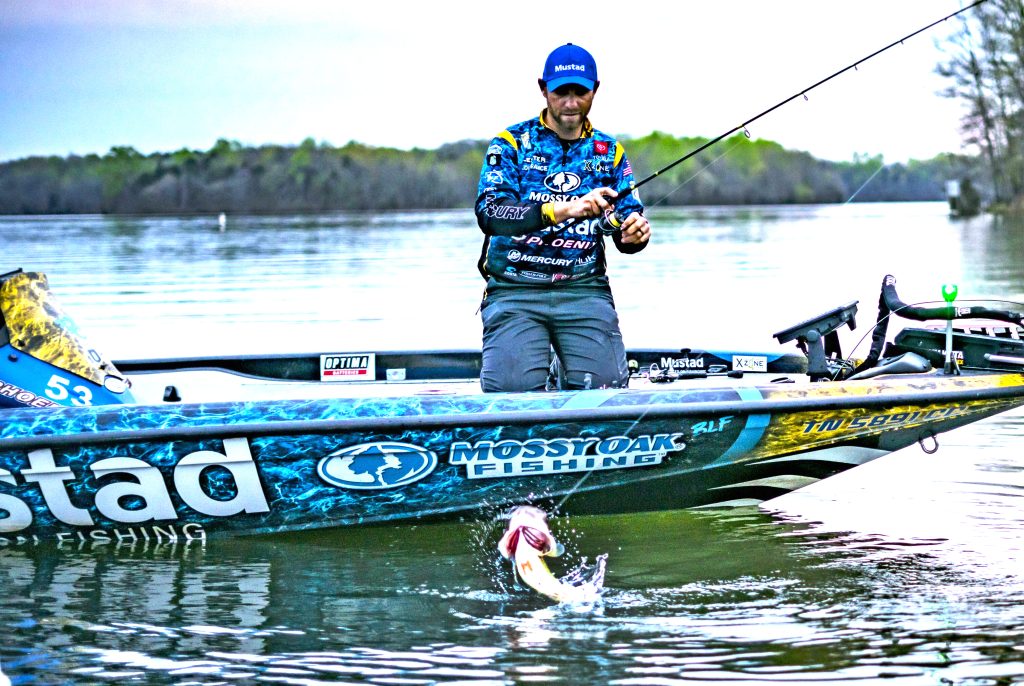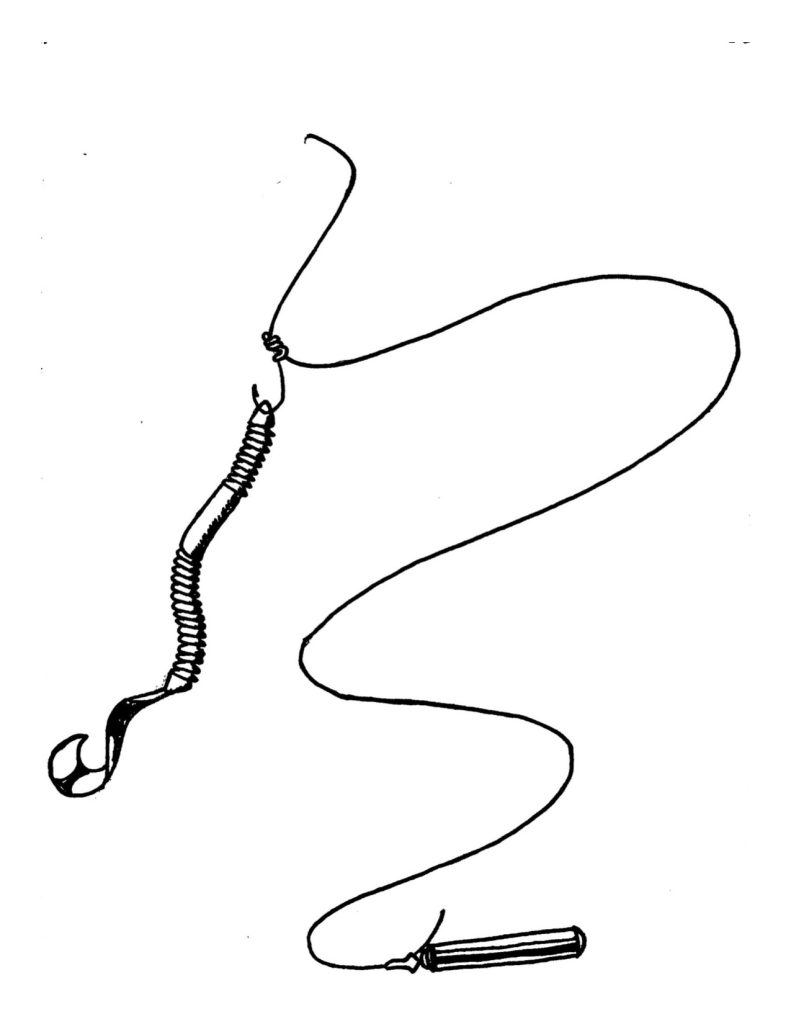Mastering The Drop Shot Rig For Bass Fishing
When fishing the drop shot rig in heavy cover, Brandon Lester realizes he may lose some bass, but first he’s got to get them to bite, which is what the drop shot rig for bass does best.
Writer’s Note: Brandon Lester of Fayetteville, has been a professional bass fisherman on the Bassmaster Elite circuit for nine years and has been competing professionally for 15 years, winning $1 million. He learned his love for bass fishing from his dad and granddad and was a founding member of the University of Tennessee at Chattanooga Bass Club.
“When getting a bass to bite is tough, I’ll always go to the drop shot rig to use, particularly when I know there’s been a lot of fishing pressure on the lake where I’m fishing,” Lester explained. “The drop shot rig started becoming a national phenomenon in the early 2000s when West Coast anglers brought this tactic from California where they fished many clear-water lakes. Drop shot rigs were made to be fished with light line and finesse lures, using smaller baits than the big bubba baits that most tournament anglers were fishing at that time. Anglers from the West Coast, like the late Aaron Martens, Skeet Reese and others, utilized this new tactic in the South and the East too. Across the nation, other fishermen were highly successful in tournaments with this technique, under many different fishing conditions.
Lester went on to say that the the drop shot fishing rig is a very-versatile tactic to use to catch bass.

When bass fishing gets tough, Brandon Lester depends on his drop shot rig to get bass bites.
“I don’t believe there’s a bad weather or water condition or time of year when the drop shot won’t produce bass,” Lester said. “I fish it in shallow water, deep water, stained water and clear water. You may have to tweak the drop shot rig somewhat, depending on the depth of water you’re fishing, the available cover and the water conditions. But I have fished the drop shot rig successfully in 2 feet of water as well as 50 feet of water and deeper.”
Lester’s Equipment to Catch Bass with the Drop Shot Rig
Lester fishes the drop shot bass rig with a 6’10” Mustad Instinct Brandon Lester signature spinning rod, which is a medium-action rod. He also uses a 2500 size spinning reel and 10-pound-test Braided Line in the highly-visible yellow color. He fishes with the highly-visible yellow line because he may see more bites on that line than he’ll feel on the rod.
Next, Lester ties a 6-10-foot-long leader of fluorocarbon line from the braided line. To connect the fluorocarbon to the braided line, Lester uses an FG Knot. At the bottom of his leader, he adds a Mustad tungsten weight, weighing most often 1/4-ounce. Depending on the type of bottom and cover he’s fishing, Lester may tie his hook onto the leader about 6-18 inches up from the weight. Most of the time, he’ll tie his hook 10 inches up from the weight.

Brandon Lester ties a Mustad 1/4-ounce tungsten weight to the bottom of his leader and then ties on a KVD Grip-Pin soft-plastic hook – generally about 10 inches above the weight.
“My rule of thumb is, the closer your weight is to the bait you’re fishing on the drop shot rig, the less action you can give your lure,” Lester explained. “The further you put your hook up the line away from the weight, the more action you can give your lure. If I’m fishing in cold water, expecting the bass to be closer to the bottom, I’ll fish with my hook or lure closer to the weight. If the water’s warm, I want my hook and my lure to be further up the line, assuming that the bass will be suspended further from the bottom.”
Lester fishes two different hooks that he attaches to his leader line. If he fishes in open water where he’s not concerned about his bait getting hung, he uses a Mustad TitanX Wacky Neko hook in size 4.
“If I’m fishing in brush or grass and want to rig my bait weedless, I’ll use a Mustad Grip-Pin that’s designed with a molded resin pin that securely anchors a wide range of baits to a hook for a no-slip, no-slide design. I attach the hook to my line with a Palomar knot, and then I run the tag end of the line back through the eye of the hook (You must tie the hook onto the line before you tie the weight to the end of the line). This method of tying your hook causes the hook and the lure to stand out perpendicular to the line.”
Lester’s favorite bait when fishing the drop shot rig is a six inch Roboworm, a West Coast style of soft, plastic worm. This style of worm seems to produce bass in all the lakes he fishes.

This picture of a drop shot rig shows that it’s built to effectively catch bass
“If I’m fishing in open water, I will nose-hook the Roboworm, so the hook is open,” Lester explained. “If I’m fishing around cover or grass, I’ll rig the worm Texas-style (weedless). My favorite color in a Roboworm is Margarita Mutilator that’s purple on top and brown on the bottom. This color seems to work best in off-color and stained water. If I’m fishing in clear water, I like to use the Morning Dawn color, which is a transparent pink.”
Tactics for Fishing the Drop Shot Worm
Making sure that your lead hits the bottom before you start reeling the drop shot is critical to being successful. This mistake may be one of the biggest that anglers make when fishing the drop shot rig. This style of fishing has been created to get the lure off the bottom but stay close to the bottom where the angler believes the bass to be or has seen the bass on his depth finder.
Lester explains that he wants to make sure his line becomes slack before he starts working the drop shot worm.
“The drop shot rig is not nearly as effective when you have a tight line to the weight on the bottom as it is when you have a slack line. By having slack in the line, when you shake that slack line with your rod tip, that’s what gives the worm its action,” Lester explained. “I want the worm to appear as lifelike and as active as it can be. When the bass inhales the worm, the only way I can know that the bass has attacked is when the highly-visible slack line twitches. Then that’s when I’ll set the hook.”
If Lester doesn’t get a bite the first time, he shakes the drop shot worm, after the lead hits the bottom, he drags the lead about two feet across the bottom and then shakes the slack line again. He repeats this same style of retrieving all the way back to the boat.

Even when fishing the backs of creeks in very-shallow water, you can use the drop shot rig to get bass to bite.
“One question I’m often asked is, ‘Because the hook on the drop shot rig that you’re using is small, and the fluorocarbon line is light, how do you get a good hookset when you decide to set the hook?’ I start fishing with my drag set light. Once I’ve set the hook on the bass, I want the line to give a little,” he said. “The rod I’m using is forgiving, and I never have a problem with a bass straightening my hook – even when the fish dives into heavy cover. I want the bass to pull line off my reel when I set the hook, and when the fish runs.”
“If the bass dives into grass or brush, I’ll try to keep pressure on the line just enough to let the bass work its way out of the grass or the brush. I don’t want to put so-much pressure on the line that it causes the line to break,” he noted. “To be honest, when I’m fishing the drop shot rig in heavy cover, I realize I’ll lose some bass. But my theory is, you must get a bass to bite the bait before you worry about how you’ll get that fish out of the cover and land it. If the bass doesn’t bite, you won’t catch it anyway. I know that the drop shot rig makes bass bite.”
Lester mentions he always has a drop shot rig on a spinning rod laying on his casting deck within easy reach, in every tournament in which he competes. “If I’m struggling to get a bite when I’m in a tournament, then I’ll use a drop shot and possibly start getting bites. The drop shot presents a bait in a different way from what the bass may have seen before,” Lester added.
Since Lester often fishes light lines and little lures like the drop shot, some anglers may think the drop shot rig only produces little bass. But Lester reports, “That’s just not true. I was fishing a bass tournament on Lake Fork in Texas during the fall, two years ago, in a Bassmaster Elite series event, casting a drop shot rig. During that tournament, I caught and landed an eight pound largemouth on the drop shot. So, I know the drop shot rig catches big bass as often as it catches little bass.”
If you’re having a hard time catching bass, don’t hesitate to fish a drop shot rig. That’s what Brandon Lester and other professional bass anglers do when there’s money and trophies on the line.
Full Disclosure: This post may include affiliate links. There’s no extra charge to our readers for using these.
